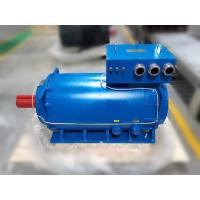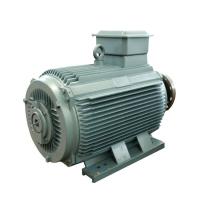Detailed pictures
PM motor structures
PM motor structures can be separated into two categories: interior
and surface. Each category has its subset of categories. A surface
PM motor can have its magnets on or inset into the surface of the
rotor, to increase the robustness of the design. An interior
permanent magnet motor positioning and design can vary widely. The
IPM motor’s magnets can be inset as a large block or staggered as
they come closer to the core. Another method is to have them
embedded in a spoke pattern.
Back-emf waveform
Back emf is short for back electromotive force but is also known as
the counter-electromotive force. The back electromotive force is
the voltage that occurs in electric motors when there is a relative
motion between the stator windings and the rotor’s magnetic field.
The geometric properties of the rotor will determine the shape of
the back-emf waveform. These waveforms can be sinusoidal,
trapezoidal, triangular, or something in between.
Both induction and PM machines generate back-emf waveforms. In an
induction machine, the back-emf waveform will decay as the residual
rotor field slowly decays because of the lack of a stator field.
However, with a PM machine, the rotor generates its own magnetic
field. Therefore, a voltage can be induced in the stator windings
whenever the rotor is in motion. Back-emf voltage will rise
linearly with speed and is a crucial factor in determining maximum
operating speed.

A PM motor can be separated into two main categories: surface
permanent magnet motors (SPM) and interior permanent magnet motors
(IPM). Neither motor design type contains rotor bars. Both types
generate magnetic flux by the permanent magnets affixed to or
inside of the rotor.
SPM motors have magnets affixed to the exterior of the rotor
surface. Because of this mechanical mounting, their mechanical
strength is weaker than that of IPM motors. The weakened mechanical
strength limits the motor’s maximum safe mechanical speed. In
addition, these motors exhibit very limited magnetic saliency (Ld ≈
Lq). Inductance values measured at the rotor terminals are
consistent regardless of the rotor position. Because of the near
unity saliency ratio, SPM motor designs rely significantly, if not
completely, on the magnetic torque component to produce torque.
IPM motors have a permanent magnet embedded into the rotor itself.
Unlike their SPM counterparts, the location of the permanent
magnets makes IPM motors very mechanically sound, and suitable for
operating at very high speeds. These motors also are defined by
their relatively high magnetic saliency ratio (Lq > Ld). Due to
their magnetic saliency, an IPM motor has the ability to generate
torque by taking advantage of both the magnetic and reluctance
torque components of the motor.
Self-sensing versus closed-loop operation
Recent advances in drive technology allow standard ac drives to
“self-detect” and track the motor magnet position. A closed-loop
system typically uses the z-pulse channel to optimize performance.
Through certain routines, the drive knows the exact position of the
motor magnet by tracking the A/B channels and correcting for errors
with the z-channel. Knowing the exact position of the magnet allows
for optimum torque production resulting in optimum efficiency.
What applications use PMSM motors?
Industries that use PMSM motors include Metallurgical, Ceramic,
Rubber, Petroleum, Textiles, and many others. PMSM motors can be
designed to operate at synchronous speed from a supply of constant
voltage and frequency as well as Variable Speed Drive (VSD)
applications. Widely used in electric vehicles (EVs) due to high
efficiency and power and torque densities, they are generally a
superior choice in high torque applications such as mixers,
grinders, pumps, fans, blowers, conveyors, and industrial
applications where traditionally induction motors are found.
Permanent magnet synchronous motors with internal magnets: Maximum
energy efficiency
The permanent magnet synchronous motor with internal magnets
(IPMSM) is the ideal motor for traction applications where the
maximum torque does not occur at maximum speed. This type of motor
is used in applications that require high dynamics and overload
capacity. And it is also the perfect choice if you want to operate
fans or pumps in the IE4 and IE5 range. The high purchase costs are
usually recouped through energy savings over the run time, provided
that you operate it with the right variable frequency drive.
Our motor-mounted variable frequency drives use an integrated
control strategy based on MTPA (Maximum Torque per Ampere). This
allows you to operate your permanent magnet synchronous motors with
maximum energy efficiency. The overload of 200 %, the excellent
starting torque, and the extended speed control range also allow
you to fully exploit the motor rating. For fast recovery of costs
and the most efficient control processes.
Permanent magnet synchronous motors with external magnets for
classic servo applications
Permanent magnet synchronous motors with external magnets (SPMSM)
are ideal motors when you need high overloads and rapid
acceleration, for example in classic servo applications. The
elongated design also results in low mass inertia and can be
optimally installed. However, one disadvantage of the system
consisting of SPMSM and variable frequency drive is the costs
associated with it, as expensive plug technology and high-quality
encoders are often used.
Flux weakening/intensifying of PM motors
Flux in a permanent magnet motor is generated by the magnets. The
flux field follows a certain path, which can be boosted or opposed.
Boosting or intensifying the flux field will allow the motor to
temporarily increase torque production. Opposing the flux field
will negate the existing magnet field of the motor. The reduced
magnet field will limit torque production, but reduce the back-emf
voltage. The reduced back-emf voltage frees up the voltage to push
the motor to operate at higher output speeds. Both types of
operation require additional motor current. The direction of the
motor current across the d-axis, provided by the motor controller,
determines the desired effect.
Benefits of PMSM motors
High efficiency
This is particularly true at lower speeds. The permanent magnet
motor does not require current to be supplied to its rotor to
generate the rotor field, therefore eliminating the rotor losses
almost completely. When compared to induction or reluctance motors
it also requires lower currents on the stator and has a bigger
power factor, leading to smaller current ratings on the controller,
and increasing the overall drive system efficiency.
Driving lower speeds at higher efficiency than an induction motor
might delete the requirement of a speed-reduction transmission,
taking the complexity out of the mechanical arrangement.
Constant torque
This type of motor can generate constant torque and maintain full
torque at low speeds.
Size
The smaller size, lighter weight, and less coil provide a higher
power density.
Cost-effective
With the absence of brushes, there are reduced maintenance costs.
Minimal heat
In PMSM the heat is generated on the stator coils and there are no
brushes and only minimal heat generated on the rotor, facilitating
the cooling of the motor. As they run cooler than induction motors,
the motor's reliability and lifespan are increased.
Speed range
This type of motor can have a wide speed range with the use of
Field Weakening and can adopt the maximum torque/current (MTPA)
control strategy during constant torque operation.










